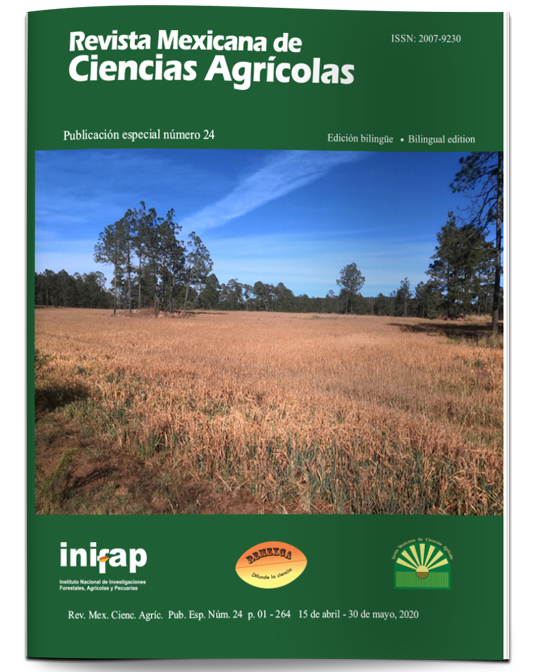Productive response of bird’s foot clover as a function of the percentage of light intercepted
DOI:
https://doi.org/10.29312/remexca.v0i24.2362Keywords:
botanical and morphological composition, harvest intervals, forage productionAbstract
The productivity of a forage species can be described in terms of the behavior of its morphological components and the combination with the entity in the grassland. The objective was to evaluate the productive behavior of bird’s foot clover (L. corniculatus), under different defoliation strategies. The experiment was carried out at the Postgraduate College, from September 2015 to September 2016, in a randomized block design, with three repetitions, with the hypothesis that when harvesting the species at 95% intercepted light (IL); it has a better productive behavior. A fixed cutoff interval (FC) had lower production in winter (3 441 kg DM ha-1), summer (5 024 kg DM ha-1) and accumulated annual (20 710 kg DM ha-1), compared to the rest of the treatments (26 689 kg DM ha-1, annual average). Also, it showed lower plant height (21 vs 26 cm, average in the IL). However, the FC had a higher leaf: stem ratio, both seasonal and annual average (2.3 vs 1.5 average in the IL). The highest seasonal values were recorded in autumn and winter (1.9). In spring and summer, the highest heights were presented with 29 cm vs. winter with 19 cm. The leaf contributed 51% to the annual yield, followed by the stem, weeds and dead material with 32, 10 and 6%, respectively. In conclusion, the best productive performance of bird’s foot clover, genotype 260012, was presented in the IL harvest strategies with respect to the FC.
Downloads
Downloads
Published
How to Cite
Issue
Section
License
The authors who publish in Revista Mexicana de Ciencias Agrícolas accept the following conditions:
In accordance with copyright laws, Revista Mexicana de Ciencias Agrícolas recognizes and respects the authors’ moral right and ownership of property rights which will be transferred to the journal for dissemination in open access. Invariably, all the authors have to sign a letter of transfer of property rights and of originality of the article to Instituto Nacional de Investigaciones Forestales, Agrícolas y Pecuarias (INIFAP) [National Institute of Forestry, Agricultural and Livestock Research]. The author(s) must pay a fee for the reception of articles before proceeding to editorial review.
All the texts published by Revista Mexicana de Ciencias Agrícolas —with no exception— are distributed under a Creative Commons License Attribution-NonCommercial 4.0 International (CC BY-NC 4.0), which allows third parties to use the publication as long as the work’s authorship and its first publication in this journal are mentioned.
The author(s) can enter into independent and additional contractual agreements for the nonexclusive distribution of the version of the article published in Revista Mexicana de Ciencias Agrícolas (for example include it into an institutional repository or publish it in a book) as long as it is clearly and explicitly indicated that the work was published for the first time in Revista Mexicana de Ciencias Agrícolas.
For all the above, the authors shall send the Letter-transfer of Property Rights for the first publication duly filled in and signed by the author(s). This form must be sent as a PDF file to: revista_atm@yahoo.com.mx; cienciasagricola@inifap.gob.mx; remexca2017@gmail.
This work is licensed under a Creative Commons Attribution-Noncommercial 4.0 International license.



